With their unique, eye-catching appearance, Cornish rex cats are perfect for people with avant-garde tastes. Learn all about this regal cat breed.
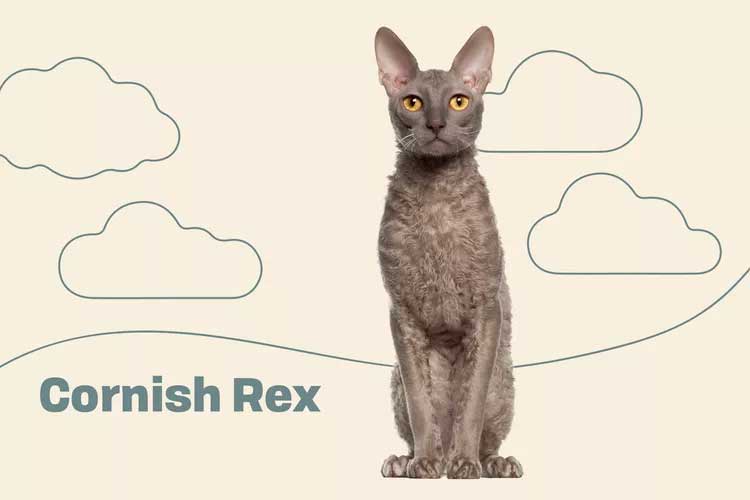
Cornish Rex Overview
| OFFICIAL NAME | Cornish Rex |
| COMMON NAME | Cornish Rex |
| PET HEIGHT | 8 to 12 inches |
| PET WEIGHT | 6 to 10 pounds |
| LIFESPAN | 11 to 15 years |
| GOOD WITH | cats, families |
| TEMPERAMENT | bold, sociable |
| INTELLIGENCE | high |
| SHEDDING AMOUNT | infrequent |
| PLAYFULNESS | high |
| ENERGY LEVEL | hyper |
| VOCAL LEVEL | frequent |
| COAT LENGTH | short |
| COLORS | black / ebony, blue / gray, chocolate / brown / sable, cream / beige / tan, red / orange, white |
| OTHER TRAITS | easy to groom, friendly toward humans, friendly toward other pets, friendly toward strangers, strong loyalty tendencies, tolerates being picked up |
With their long and slender bodies, large eyes, and huge ears, the Cornish rex is a cat sure to spark conversation—and those aren't even their most unique feature. The Cornish rex lacks the long hair of an outer coat, leaving her with just a curly, soft down undercoat that feels like velvet when you pet her.
But these kitties aren't just looks. Cornish rex cats are high-energy and playful, and you will often find them peering down at you from the top of your refrigerator. If you're looking for a spirited indoor companion, a Cornish rex will fit right into your home.
Appearance
The Cornish rex's body is extremely slender, giving her the appearance of being fragile. This is all a ruse, since everything under the skin is hard muscle and bone, and they are surprisingly sturdy and energetic cats.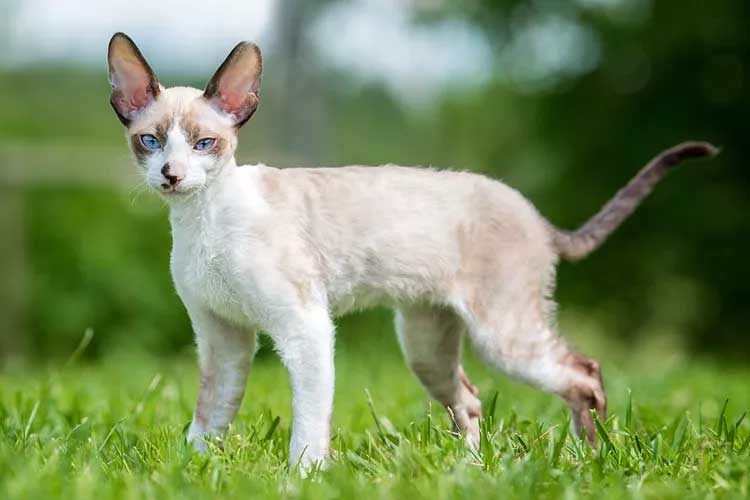
Their bodies are topped by a smallish, egg-shaped head that carries high cheekbones; large, round eyes; a long nose; and giant ears situated at the top of the skull. But the main hallmark of the Cornish rex is her coat. Where most breeds have three different types of hair—the long outer guard hairs, a middle layer of awn hair, and the down undercoat—Cornish rex cats only have the third down coat, giving them a soft, wavy appearance that feels like velvet.
But these Cornish kitties aren't the only cat breed with this distinct coat; the lean and muscular Devon rex also has soft down fur, and the breeds are often confused. But Chyrle Bonk, DVM at Petkeen, says you can differentiate the Cornish rex vs. Devon rex by their faces. The Devon rex has a wide face with lower-set ears, while the Cornish rex has a triangular and lean face, she says. The Cornish rex's hair tends to be slightly shorter than the Devon's as well.
You might have heard that the Cornish rex is hypoallergenic, though this isn't technically true. The Cornish rex may shed less than some other breeds thanks to her short, curly coat, but people with cat allergies aren't reacting to the cat hair itself. Most cat allergies are actually from a glyco-protein known as Fel d 1, produced in the sebaceous glands of the skin, as well as in saliva and urine. As cats clean themselves, their saliva dries on their fur and flakes off as they move, causing the dander that most people react to. For this reason, while a Cornish rex may create a lower reaction in people with cat allergies, the potential for reaction will still be there, since they still groom themselves. Before bringing home a Cornish rex kitten, spend time with the breed to see how your allergies react.
Temperament
The Cornish rex is an incredibly curious, bright, high-energy breed. Emphases on the high-energy."Cornish rexes may be seen as the border collies of the cat world," Bonk says. "They're always on the move and do better if they have a job to do. While they really enjoy playing with you, interactive toys, such as battery-operated mice, puzzle toys, or maze toys, can help keep them entertained when you can't play with them."
True explorers, the Cornish rex will find her way up into places you previously thought to be inaccessible, like the top of your kitchen cabinets. Cat-proofing your home is going to be a necessity to keep the rex out of places you don't want her to go.
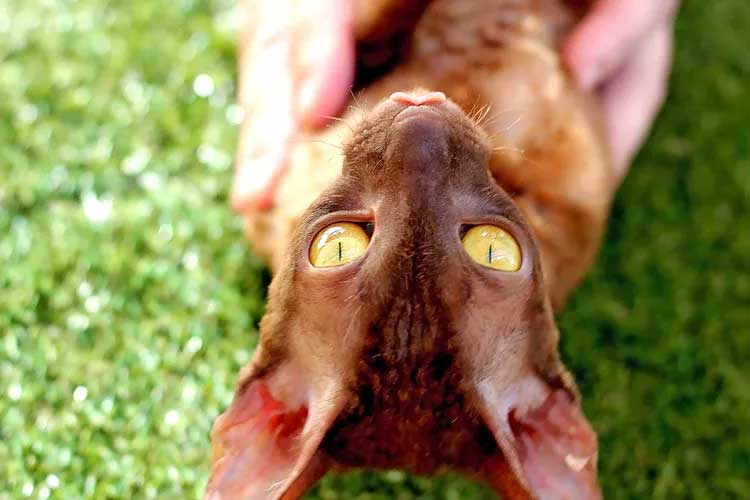
And when your little explorer isn't scaling door frames or wiggling her way into slightly ajar drawers, she's probably following you from room to room.
"The Cornish rex is a very social cat," Bonk says. "They love being around others. However, they are also loyal to their family and may not immediately take to strangers, but don't expect them to give a new person the cold shoulder for long."
They love to interact with people in every way imaginable, Bonk says, including "talking" to them. And while they're not as chatty as the Siamese, the Cornish rex will definitely let you know what they're thinking—or when their food bowl is empty.
Living Needs
When you bring home a Cornish rex kitten, she's going to need places to explore. A natural born climber and jumper, she'll be thrilled with a cat tree (or two), some cat shelves mounted to the walls, and a window hammock where she can lounge.Your rex will also need a nice, cozy, and (most importantly) warm cat bed. Her incredibly short coat might be cute and soft, but it doesn't do much to keep her warm. So when she does settle down from a day of play, she's going to seek out the warmest spot—a bed, your laptop, or you. A cute cat sweater will help keep her cozy, and if you ever let her outside on a catio or explore on a harness, make sure she's wearing a warm coat.

But other than places to climb, fun toys to bat around, and a warm spot to retire to, the Cornish rex doesn't have a long list of demands. These social kitties fit right in to most home and families.
"Cornish rexes tend to love everybody," Bonk says. "Their high activity level and playfulness makes them work well with children, but be sure to teach your child how to properly interact with them first."
Bonk says Cornish rexes like having other furry siblings—cats or dogs—especially if they're willing to play.
Care
The Cornish rex's short, curly coats are about as low-maintenance as you can get, and Bonk says it's best to keep brushing to a minimum.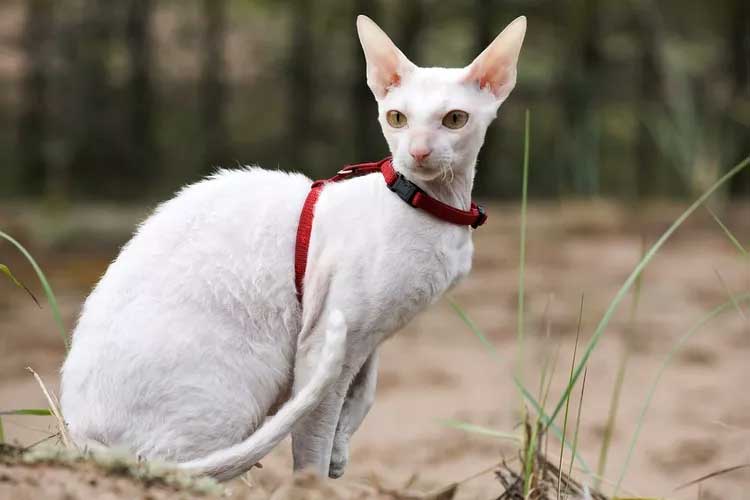
"Too much brushing can actually harm these delicate hairs," she says. "Rather than frequent brushing, you'll want to do at least a weekly ear and paw cleanings. This will help reduce excessive oils and greasiness from developing."
You'll also need to keep her nails trimmed short, her litter box clean, and her teeth brushed.
It's important to keep your Cornish rex inside. Along with her issues with cold weather, she can be sunburned if she's out in the sun for too long.
Health
The typical Cornish rex lifespan is long—15 is the norm, but rexes living for 20 years isn't uncommon—and the breed has virtually no hereditary or genetic health problems.While being free of any breed-specific health concerns, Cornish rex cats are prone to many of the same general maladies that can befall multiple cat breeds.
"The most common thing we see in cats as far as disease is kidney disease. That's really just across the board in cats," says Michelle Beck, DVM, CCRT, CVA, of the Backlund Animal Clinic in Omaha, Neb. "Kidney disease and heart disease are things that vets know to check all cats for, just as a matter of course.
"Cats by the age of 10, almost 70 percent of them have arthritis somewhere in their body," Beck continues. "Cats are very good at hiding their pain."
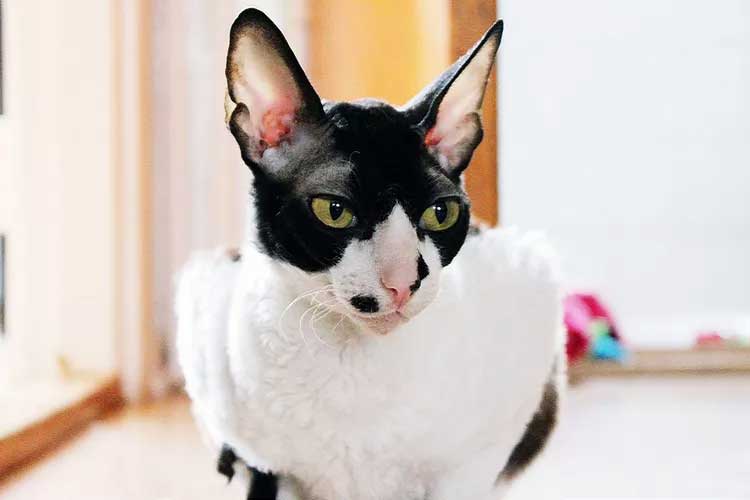
Beck says that ability to mask pain—especially in breeds that aren't well-known for having specific health issues—can cause a lot of cat owners to forego things like routine vet visits or preventative care.
"It's not that we don't have great care available for cats," Beck says. "It's just that we don't see a lot of cats. If they're an indoor cat, they're not exposed to a lot of disease."
History
While in most cases a country of origin and perhaps a century are about as close as you can get, the Cornish rex has an actual birthday: July 21, 1950.That was the day that Serena, a tortoise shell cat on a farm in Cornwall, England, gave birth to a litter of kittens that included one male kitten who was cream-colored and covered in tight, soft curls. As he grew, that kitten (eventually named Kallibunker) became even more dramatically different from his littermates with a slender body, long, thin legs, huge bat ears, and a whippy tail.

Farm owner Nina Ennismore took Kallibunker to the vet for an examination and neutering but was discouraged against the latter by her vet, who identified Kallibunker as a wholly unique genetic mutation, according to the Cat Fanciers' Association. Instead, Ennismore took him home, bred him back to his mother and two more of the little mutants were born in Serena's following litter. The Cornish rex was off and running. In 1957, two Cornish rexes were imported to the U.S. and breeding began here in earnest.
In 1960, Beryl Cox of Devonshire, England, found a stray cat with a small, round face and short, curly coat, according to the CFA. Originally thought to be another Cornish rex, attempts were made to breed that cat (named Kirlee) with other Cornish rex cats, but the litters produced straight-haired kittens. Kirlee was found to possess a similar but distinct gene mutation, which became the foundation for the Devon rex breed. While the two look very similar, and were, in fact, shown together for a number of years, they are genetically distinct and cross breeding them is discouraged.
Fun Facts
The curl in the Cornish rex's fur isn't limited to their coats. The breed's whiskers and eyelashes are curly as well!The oils in the Cornish rex's skin has a unique scent. Not unpleasant, owners often describe the cats as smelling "cheesy."
They're sometimes called "marcel cats," because the wave in their fur resembles the "marcel wave" hairstyle that was popular with flappers in the 1920s.
The rex in Cornish rex is latin for "king."